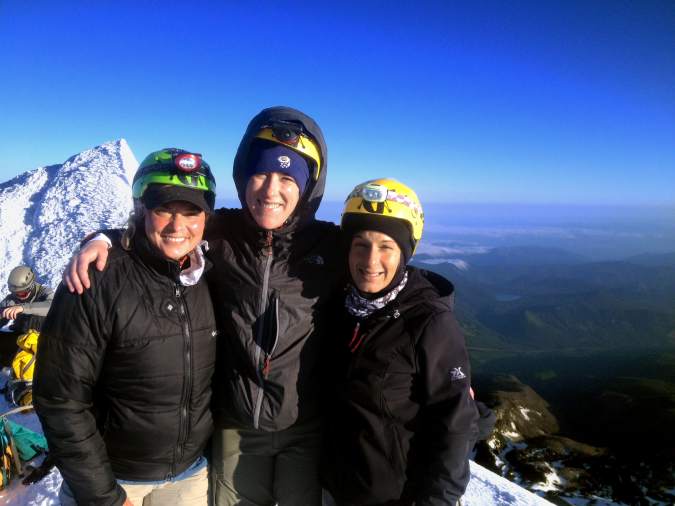-

Climbing Out of Homelessness With Seattle’s Union Gospel Mission
Recovery Beyond Featured In

If you appreciate metaphors, they’re everywhere in the Union Gospel Mission’s annual Mount Rainier climb. Now in its fourth year, the program takes 16 homeless men enrolled in UGM’s addiction-recovery program to Rainier’s summit. And from August 7 to 10, former Army Ranger Mike Johnson, who as UGM’s director of special projects spearheaded the program, will aim to get four more to the top—along with, for the first time in the program’s brief history, two climbers from UGM’s addiction-recovery program for women.
“Immediately, the metaphor was really powerful, like climbing out of homelessness is like climbing Mount Rainier. It’s hard. It takes a team. You need a guide. You have to get stronger than you’ve been,” Johnson says of his inspiration to get people from society’s depths up a 14,000-foot mountain. He remembers a 2010 day trip to Sunrise at which one of the men from the recovery program pointed toward the top and said, “I wish we could go up there.”
“We have to start pretty gently. We have a lot of guys who haven’t been good to themselves.”
Everything clicked, Johnson recalls, and with the help of sponsor Whittaker Mountaineering, UGM donors, and a handful of volunteer guides, an ascent of Mount Rainier has been an August tradition. Johnson starts training would-be climbers in October, welcoming anyone enrolled in the UGM 12-month recovery program. This year he started with about a dozen—a list that slowly shrank as time passed and training intensified.
“We have to start pretty gently. We have a lot of guys who haven’t been good to themselves,” Johnson says. “A couple guys usually fall off the team for relapse reasons. . . . It’s self-selecting. The group has always whittled itself down into a size I can work with.” By May, the climbers are ready for one final tall test before Rainier: “If you can’t climb Mount Hood, then you’re not going to climb Rainier. It’s just reality,” says Johnson, comparing the Oregon peak to “the sorting hat from Harry Potter.” This year he says five climbers got left on the side of the mountain. “We need people who are physically prepared,” he says simply.
Hood, of course, is just the warm-up. About 10,000 people attempt to summit Mount Rainier every year, but half fail, according to statistics from the National Park. But to hear Johnson tell it, the four days this week that UGM’s six remaining recovery-program climbers will spend tackling the most prominent mountain in the lower 48 won’t be so much a challenge as a celebration of something far bigger. In so many ways, these climbers have already made it.
“What I loved about [the idea] was that it felt like it had a lot of handles—ways for people to get a hold of what our folks [at UGM] are going through. Because I was worried, and still am, that homeless folks have a way of becoming urban wallpaper,” Johnson explains, sitting in a room a floor above UGM’s Pioneer Square men’s shelter, sweaty and not long removed from an afternoon training session with this year’s climbers. “It’s not that if you can climb Rainier, then you can climb out of homelessness. It’s if you can climb out of homelessness and addiction, then you can climb Rainier. This is the hard one.”
Sitting across from Johnson, 35-year-old Kristy Olmstead, one of this year’s two female climbers, speaks confidently, determined to join the list of UGM successes who have topped Rainier. Like the other five recovery-program climbers, Olmstead’s story is one of addiction, despair, and—now, she assures us—redemption. Olmstead says she spent a year in prison in Idaho on theft charges before coming home to Washington last year and finding her way into the UGM recovery program and onto the climbing team. “I liked it all,” Olmstead says of her history of addiction.
“One thing I learned is that if I put one foot in front of the other, I was going to get there.”
Primarily, though, she admits, methamphetamine was her drug of choice. And it was meth—more specifically, an unresolved charge of possession with intent to deliver hanging over her head in Snohomish County—that put Olmstead back in prison earlier this year for three months, even though she was enrolled in UGM’s recovery program and climb training. While others might have caved, Olmstead says the mountain was an inspiration.
She remembers improvising workouts in the prison yard to keep her training on track: banging out pushups and running in a circle, because in prison you can’t run in a straight line for long. “I was offered drugs when I was in there, and I said no, and they asked why, and I said I have a bigger plan,” Olmstead recalls.
The weekend after her release from prison, the UGM climbers took Mount Hood. And remarkably, Olmstead was right there with them. “I was just so proud of her,” Johnson says, admitting that he figured there was no way Olmstead would be prepared to climb after three months in lockup. Of this week’s Rainier trek, Johnson is far more certain. He says he knows Olmstead is ready.
“When I summited Hood I was just bawling and laughing and crying and praying. And I was just so happy, because I knew if I summited Hood, then I could still do Rainier,” she recalls.
“One thing I learned is that if I put one foot in front of the other, I was going to get there,” Olmstead says of her climbing mindset. “I wasn’t going to worry about 10 steps away. I wasn’t going to worry about how steep it looked. I just knew that if I put one foot in front of the other, that eventually I would end up at the top.”
It’s a metaphor we could all learn from.
1
